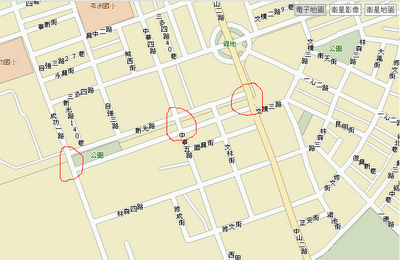臺灣人不守規矩
Are rules just for other people?

There was a brief report on the TV news the other day about how cars parked on the sidewalks at the streets perpendicular to 新光路 made the sidewalk tiles uneven and difficult for people to walk. It's not just there, of course. On 思維路, which was similarly retiled with large tiles last year, there is the same problem, and apparently they're instituting the same system all over Kaohsiung.
In fact, the report neglected other points. First of all, motorcycles cause a lot of the tiles to become uneven, too, but people here often seem loathe to criticize them.
The other thing is whether they are the old smaller, brick-sized tiles or the new ones, when they become uneven and water gets underneath, and pedestrians step on them, sometimes the water splashes up and gets on your feet.
But why use tiles anyway? What's wrong with concrete?
Kaohsiung is also refurbishing many of its city parks, and doing a fairly good job, but many of them inexplicably use cobblestones that make it hard for me to walk on, much less the elderly who are the main users of the parks.
Another disaster is the broadening and retiling of 中山路 (how do you pronounce that? Nakayama?--ha-ha). During the reconstruction there is zero provision for pedestrians, and on the parts that have been refurbished, since they're so nice and broad and flat, motorcycles often use them as their own highways.
In fact, although the vast majority of automobile drivers and a largish majority of motorcycle drivers obey the rules, a substantial number don't. I wonder if the failure to obey traffic regulations has any connection to the failure to obey other regulations, and is a reason both the DPP and KMT are so corrupt. A lot of people here think rules are for other people.

There was a brief report on the TV news the other day about how cars parked on the sidewalks at the streets perpendicular to 新光路 made the sidewalk tiles uneven and difficult for people to walk. It's not just there, of course. On 思維路, which was similarly retiled with large tiles last year, there is the same problem, and apparently they're instituting the same system all over Kaohsiung.
In fact, the report neglected other points. First of all, motorcycles cause a lot of the tiles to become uneven, too, but people here often seem loathe to criticize them.
The other thing is whether they are the old smaller, brick-sized tiles or the new ones, when they become uneven and water gets underneath, and pedestrians step on them, sometimes the water splashes up and gets on your feet.
But why use tiles anyway? What's wrong with concrete?
Kaohsiung is also refurbishing many of its city parks, and doing a fairly good job, but many of them inexplicably use cobblestones that make it hard for me to walk on, much less the elderly who are the main users of the parks.
Another disaster is the broadening and retiling of 中山路 (how do you pronounce that? Nakayama?--ha-ha). During the reconstruction there is zero provision for pedestrians, and on the parts that have been refurbished, since they're so nice and broad and flat, motorcycles often use them as their own highways.
In fact, although the vast majority of automobile drivers and a largish majority of motorcycle drivers obey the rules, a substantial number don't. I wonder if the failure to obey traffic regulations has any connection to the failure to obey other regulations, and is a reason both the DPP and KMT are so corrupt. A lot of people here think rules are for other people.
